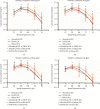Comparative Analysis of Visual Performance and Astigmatism Tolerance with Monofocal, Bifocal, and Extended Depth-of-Focus Intraocular Lenses Targeting Slight Myopia
- PMID: 33163229
- PMCID: PMC7607280
- DOI: 10.1155/2020/9283021
Comparative Analysis of Visual Performance and Astigmatism Tolerance with Monofocal, Bifocal, and Extended Depth-of-Focus Intraocular Lenses Targeting Slight Myopia
Abstract
Purpose: To compare the visual performance and astigmatism tolerance of 3 intraocular lens (IOL) groups: monofocal, bifocal, and extended depth-of-focus (EDOF) IOLs targeting slight myopia.
Methods: Overall, there were 60 cataract surgery eyes from 60 patients with implantation of a monofocal, bifocal, or EDOF IOL (20 eyes in each IOL group). The EDOF IOLs targeted slight myopia (-0.25 D to -0.75 D). Intragroup comparison of visual acuity, defocus curve, objective optical quality, contrast sensitivity, visual function questionnaire scores, patients' overall satisfaction, and the astigmatism tolerance was performed 3 months after surgery.
Results: The EDOF group provided equivalently excellent distance visual outcomes (0.06 ± 0.12) as the monofocal (0.06 ± 0.09) and bifocal (0.03 ± 0.09) groups (P=0.554), better intermediate vision than the other 2 groups (P < 0.05), and similarly satisfactory near visual outcomes (0.23 ± 0.16 at 20 cm, and 0.17 ± 0.14 at 33 cm) as the bifocal group (0.28 ± 0.14 at 20 cm and 0.08 ± 0.10 at 33 cm) (P > 0.05). The contrast sensitivity of EDOF IOL was slightly decreased compared to that of monofocal IOL, but it was better than that of bifocal IOL. The EDOF group showed significantly higher satisfaction than the bifocal group did when preoperative corneal astigmatism was 0.75 D or greater (P=0.009). A significant negative correlation between the corneal astigmatism and patient satisfaction was observed in only the bifocal group.
Conclusions: The EDOF IOLs targeting slight myopia offered satisfactory visual outcomes at an extended range from far to near distances. The EDOF and monofocal IOLs showed a better tolerance to astigmatism than did the bifocal IOL.
Copyright © 2020 Jie Xu et al.
Conflict of interest statement
The authors declare that they have no conflicts of interest.
Figures






References
-
- Monaco G., Gari M., Di Censo F., Poscia A., Ruggi G., Scialdone A. Visual performance after bilateral implantation of 2 new presbyopia-correcting intraocular lenses: trifocal versus extended range of vision. Journal of Cataract & Refractive Surgery. 2017;43(6):737–747. doi: 10.1016/j.jcrs.2017.03.037. - DOI - PubMed
LinkOut - more resources
Full Text Sources

